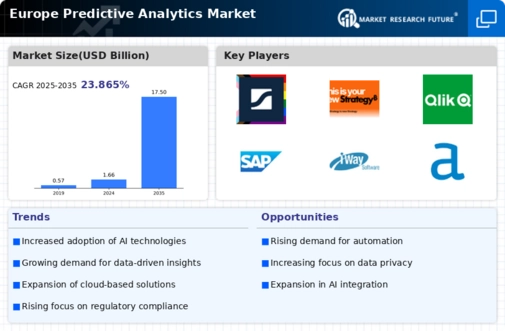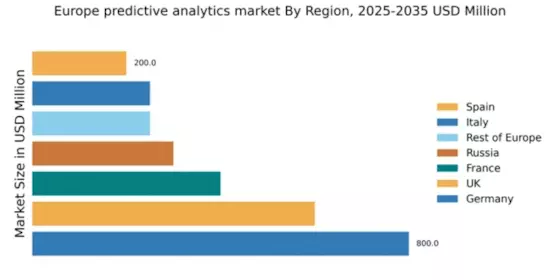Regulatory Compliance and Data Governance
The stringent regulatory landscape in Europe is a critical driver for the predictive analytics market. Organizations are increasingly required to comply with regulations such as the General Data Protection Regulation (GDPR), which mandates strict data governance practices. This regulatory environment compels businesses to adopt predictive analytics solutions that not only enhance operational efficiency but also ensure compliance with legal standards. The predictive analytics market is likely to see a surge in demand for tools that facilitate data management and compliance monitoring. As companies strive to avoid hefty fines and reputational damage, investments in predictive analytics that align with regulatory requirements are expected to rise, potentially increasing market growth by 15% annually.
Integration of IoT and Predictive Analytics
The integration of Internet of Things (IoT) technologies with predictive analytics is emerging as a transformative driver for the market in Europe. As IoT devices proliferate, they generate vast amounts of data that can be analyzed to predict trends and behaviors. This synergy is particularly beneficial in sectors such as manufacturing, logistics, and smart cities, where real-time data can inform decision-making processes. The predictive analytics market is expected to expand significantly as organizations harness IoT data to enhance operational efficiency and reduce costs. Analysts project that the market could grow by 30% over the next five years, driven by the increasing adoption of IoT solutions and the need for advanced analytics capabilities to interpret the data generated.
Advancements in Cloud Computing Technologies
The evolution of cloud computing technologies is significantly influencing the predictive analytics market in Europe. With the increasing adoption of cloud-based solutions, organizations are able to access powerful analytics tools without the need for substantial upfront investments in infrastructure. This shift is facilitating the democratization of data analytics, allowing smaller enterprises to leverage predictive capabilities that were previously accessible only to larger corporations. The cloud computing segment is expected to account for over 40% of the predictive analytics market by 2026. As businesses continue to migrate to cloud environments, the predictive analytics market is poised for substantial growth, driven by the scalability and flexibility that cloud solutions offer.
Rising Demand for Data-Driven Decision Making
The increasing emphasis on data-driven decision making is a pivotal driver for the predictive analytics market in Europe. Organizations across various sectors are recognizing the value of leveraging data to enhance operational efficiency and strategic planning. According to recent estimates, the market is projected to grow at a CAGR of approximately 25% from 2025 to 2030. This growth is largely attributed to the need for businesses to remain competitive in a rapidly evolving landscape. As companies seek to harness insights from vast datasets, the predictive analytics market is likely to experience heightened investment in advanced analytics tools and technologies. This trend is particularly pronounced in sectors such as finance, healthcare, and retail, where data insights can lead to improved customer experiences and optimized resource allocation.
Growing Importance of Customer Experience Management
The focus on customer experience management is becoming increasingly vital for businesses in Europe, driving the predictive analytics market forward. Companies are leveraging predictive analytics to gain insights into customer behavior, preferences, and trends, enabling them to tailor their offerings and enhance customer satisfaction. This trend is particularly evident in the retail and e-commerce sectors, where personalized marketing strategies are essential for maintaining competitive advantage. The predictive analytics market is projected to witness a growth rate of around 20% as organizations invest in technologies that allow for real-time customer insights and engagement strategies. By utilizing predictive analytics, businesses can anticipate customer needs and improve retention rates, ultimately leading to increased revenue.


















Leave a Comment